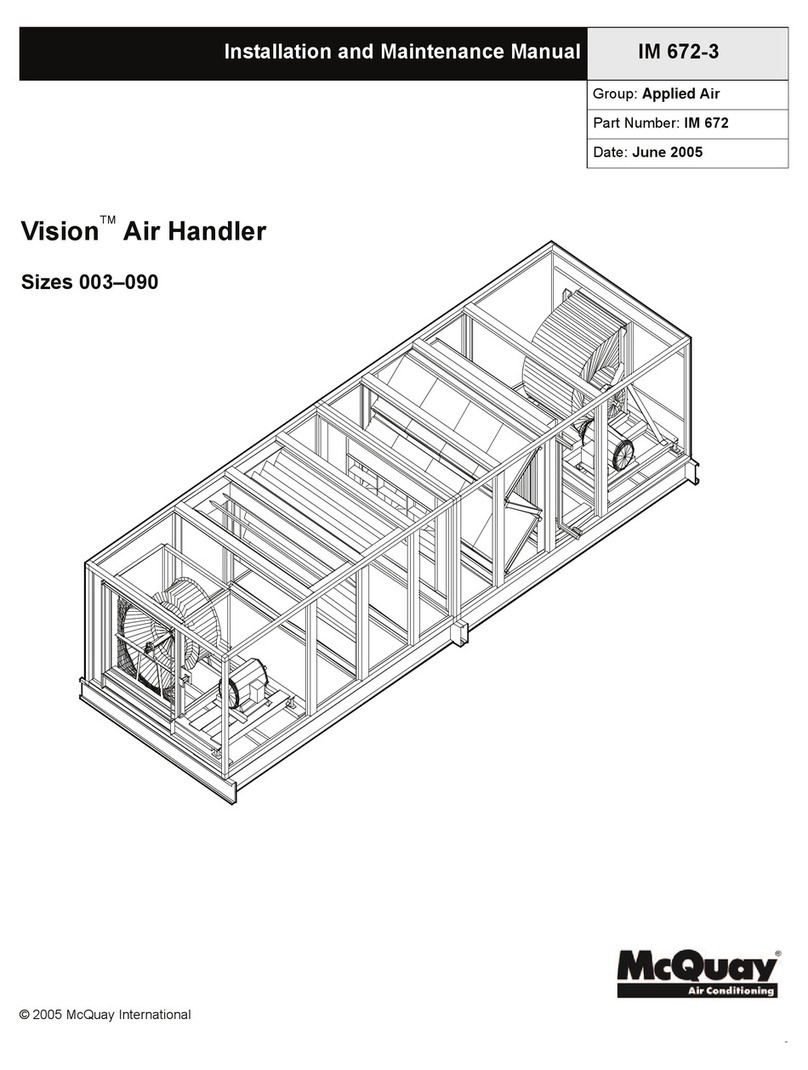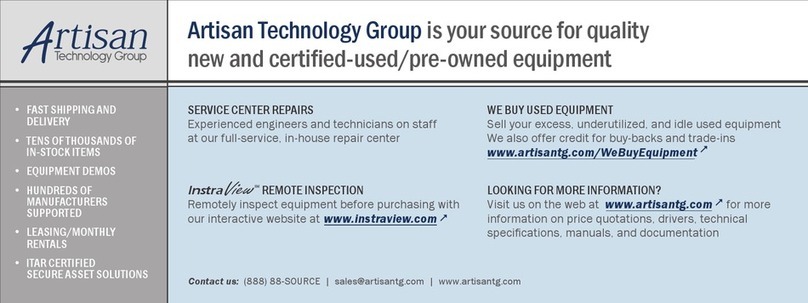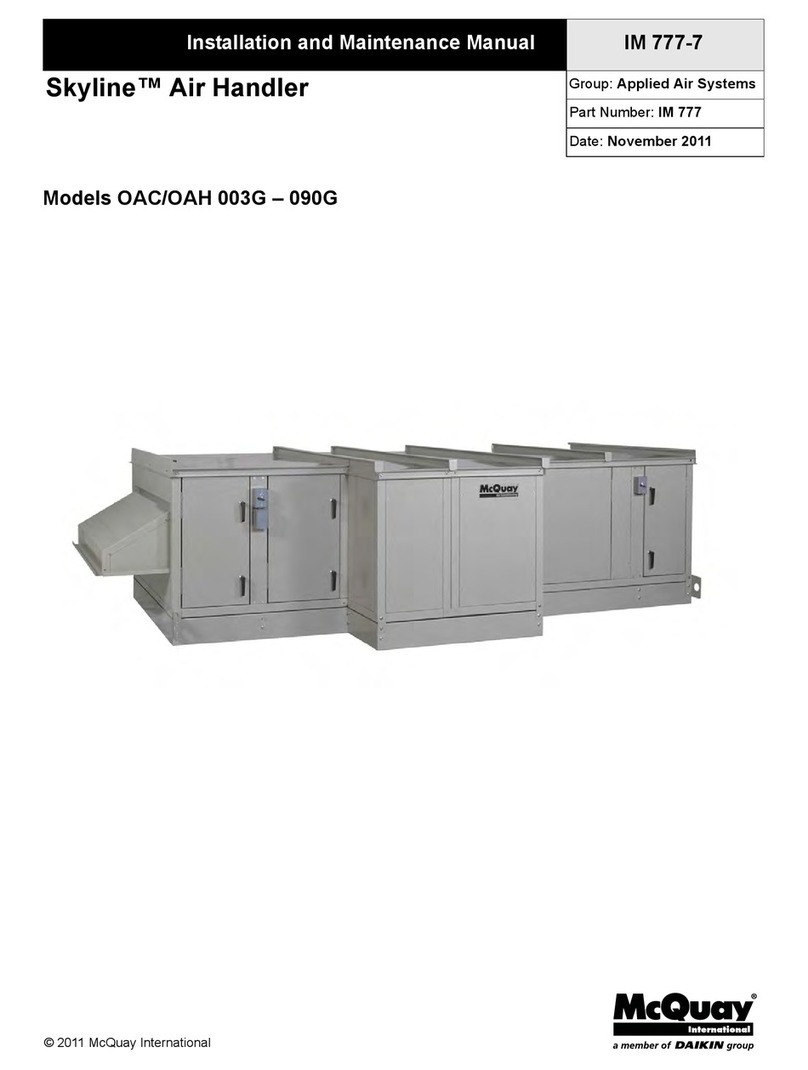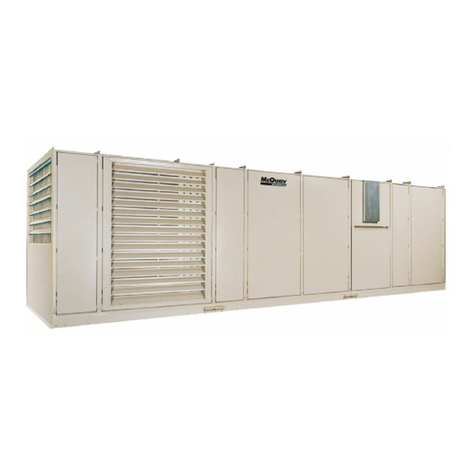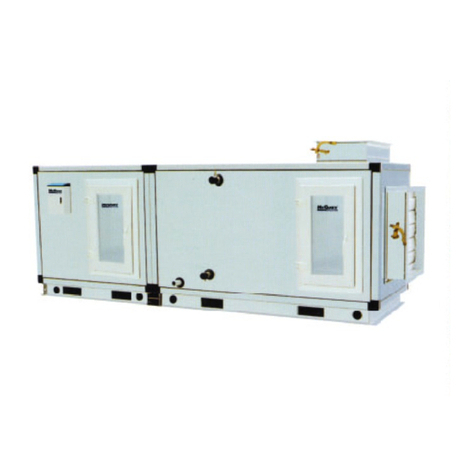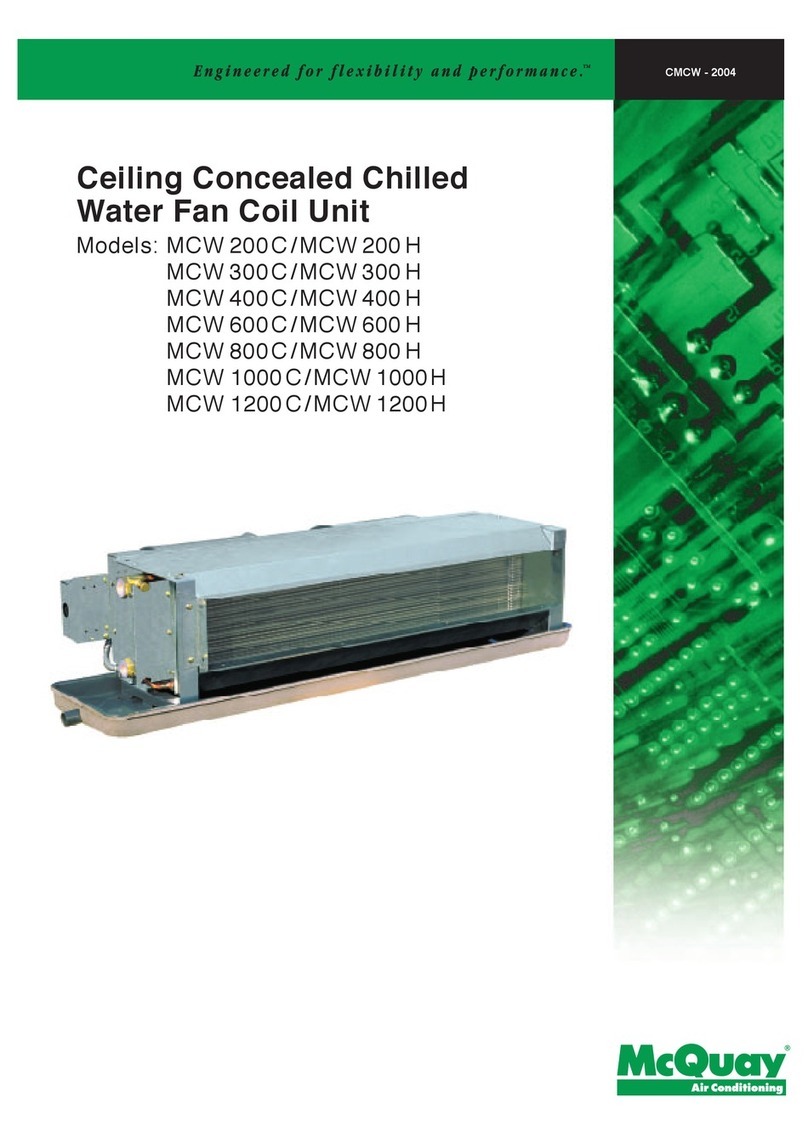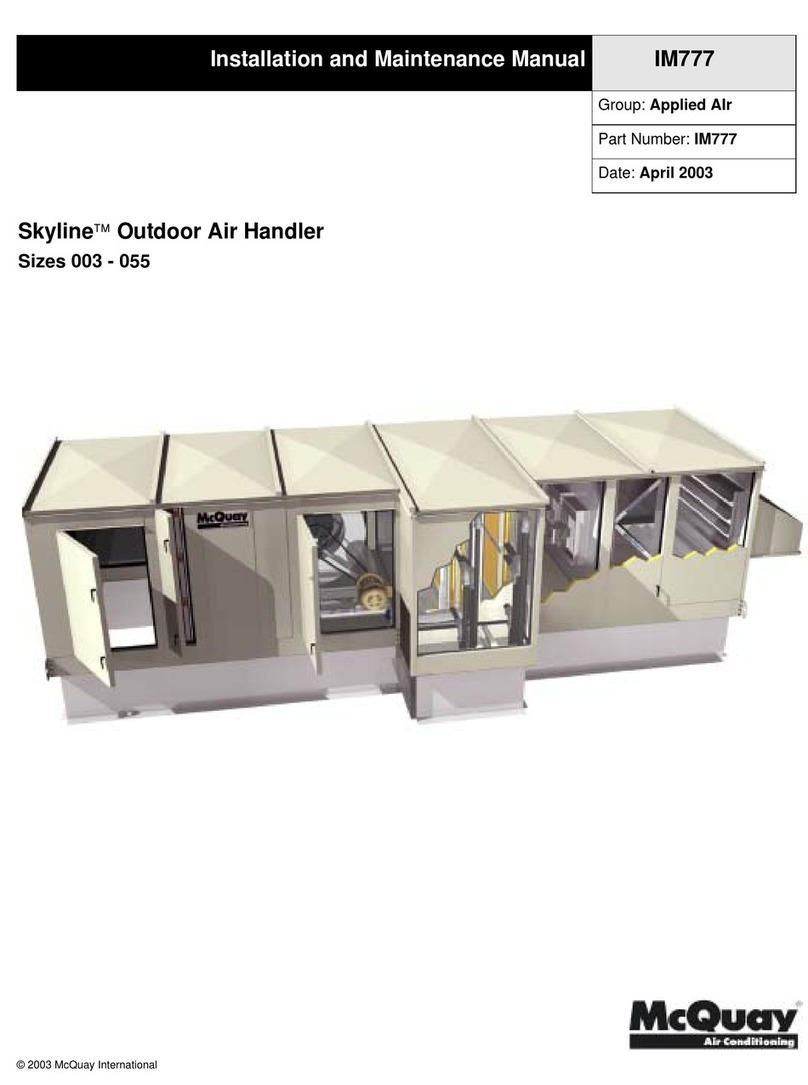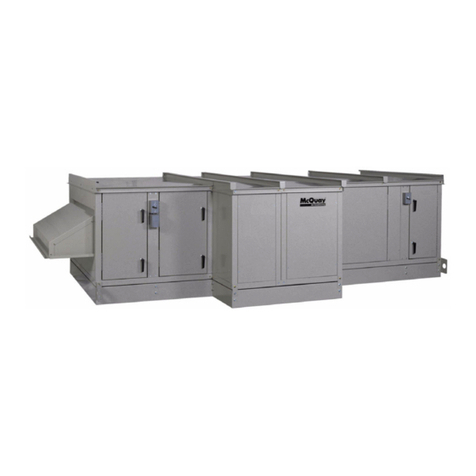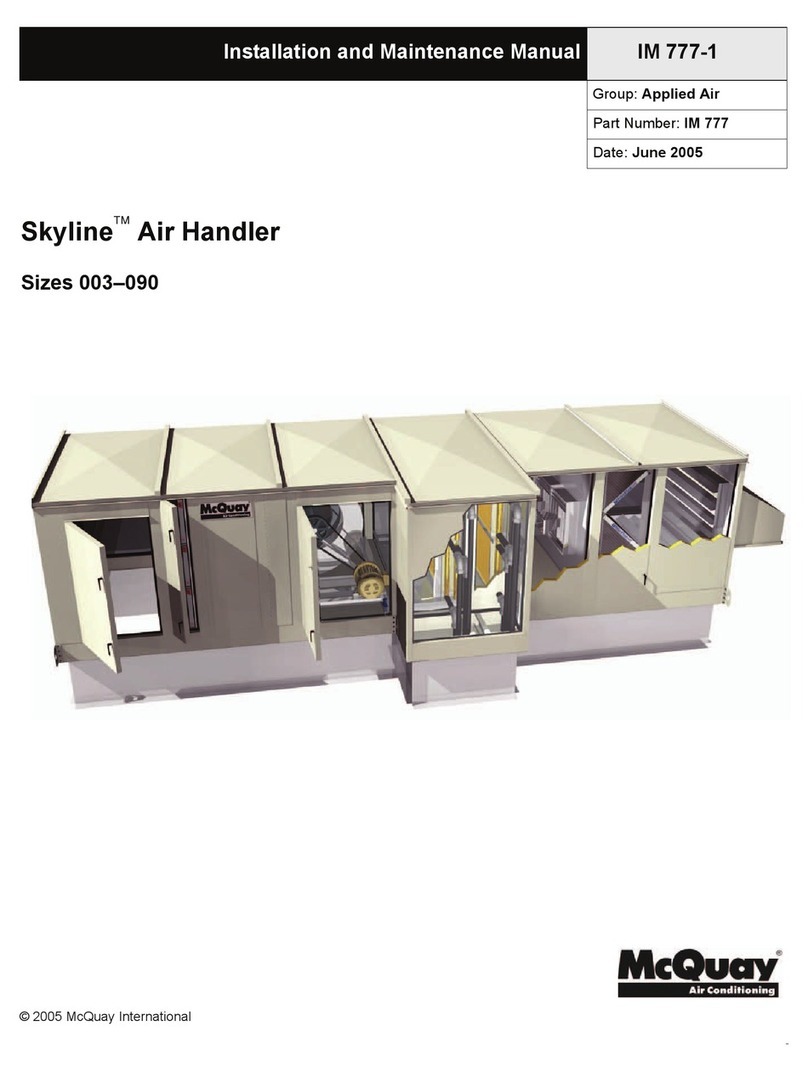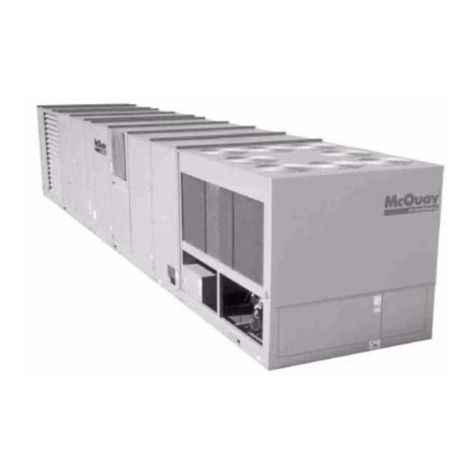
Page 2 / IM 178
Introduction . . . . . . . . . . . . . . . . . . . . . . . . . . . . . . . . . . . 3
Nomenclature . . . . . . . . . . . . . . . . . . . . . . . . . . . . . . . . 3
Receiving Inspection . . . . . . . . . . . . . . . . . . . . . . . . . . 3
Unit Description . . . . . . . . . . . . . . . . . . . . . . . . . . . . . . . . 4
Typical Component Locations . . . . . . . . . . . . . . . . . . . 4
Control Locations . . . . . . . . . . . . . . . . . . . . . . . . . . . . . 5
Control Panel Locations . . . . . . . . . . . . . . . . . . . . . . . . 6
Controls, Settings, and Functions . . . . . . . . . . . . . . . . 8
Mechanical Installation. . . . . . . . . . . . . . . . . . . . . . . . . . 10
Unit Clearances . . . . . . . . . . . . . . . . . . . . . . . . . . . . . 10
Roof Curb Assembly and Installation . . . . . . . . . . . . . 11
Post and Rail Mounting . . . . . . . . . . . . . . . . . . . . . . . 13
Rigging and Handling . . . . . . . . . . . . . . . . . . . . . . . . . 13
Installing Ductwork . . . . . . . . . . . . . . . . . . . . . . . . . . . 15
Installing Duct Static Pressure Sensor Taps . . . . . . . 15
Installing Building Static Pressure Sensor Taps . . . . 16
Condensate Drain Connection . . . . . . . . . . . . . . . . . . 17
Field Refrigerant Piping and Charging of DX Coils . . 17
Unit Piping. . . . . . . . . . . . . . . . . . . . . . . . . . . . . . . . . . 19
Vestibule Assembly Instructions . . . . . . . . . . . . . . . . 21
Damper Assemblies . . . . . . . . . . . . . . . . . . . . . . . . . . 23
Cabinet Weatherproofing . . . . . . . . . . . . . . . . . . . . . . 25
Electrical Installation . . . . . . . . . . . . . . . . . . . . . . . . . . . 26
Field Power Wiring . . . . . . . . . . . . . . . . . . . . . . . . . . . 26
Field Control Wiring . . . . . . . . . . . . . . . . . . . . . . . . . . 28
Preparing Unit For Operation . . . . . . . . . . . . . . . . . . . . . 29
Relief Damper Tie-down . . . . . . . . . . . . . . . . . . . . . . . 29
Spring Isolated Fans . . . . . . . . . . . . . . . . . . . . . . . . . . 29
Adjustment of Scroll Dampers . . . . . . . . . . . . . . . . . . 30
Adjustment of Supply Fan Thrust Restraints . . . . . . . 30
Adjustment of Seismic Restraints . . . . . . . . . . . . . . . 31
Sequences of Operation . . . . . . . . . . . . . . . . . . . . . . . . 32
Power-up . . . . . . . . . . . . . . . . . . . . . . . . . . . . . . . . . . 32
Fan Operation . . . . . . . . . . . . . . . . . . . . . . . . . . . . . . . 32
Economizer Operation . . . . . . . . . . . . . . . . . . . . . . . . 32
Cooling Operation. . . . . . . . . . . . . . . . . . . . . . . . . . . . 33
Heating Operation. . . . . . . . . . . . . . . . . . . . . . . . . . . . 33
Wiring Diagrams . . . . . . . . . . . . . . . . . . . . . . . . . . . . . . . 34
Legend . . . . . . . . . . . . . . . . . . . . . . . . . . . . . . . . . . . . 34
Typical Power Circuits With Controls. . . . . . . . . . . . . 35
Table of Contents
Typical Compressor Staging Outputs . . . . . . . . . . . . 35
Typical Main Control Circuit (VAV Units) . . . . . . . . . . 36
Typical Main Control Circuit (CAV-ZTC Units) . . . . . . 37
Typical Main Control Circuit (CAV-DTC Units). . . . . . 38
Typical Actuator Control Circuit . . . . . . . . . . . . . . . . . 39
Typical Supply/Return Fan Control Circuit . . . . . . . . 39
Typical Gas Furnace Control Circuit . . . . . . . . . . . . . 40
(Modulating Burner, Mixed Air Intake)
Typical Electric Heat Control Circuit (Multistage) . . . 41
Unit Options . . . . . . . . . . . . . . . . . . . . . . . . . . . . . . . . . . 42
Enthalpy Control . . . . . . . . . . . . . . . . . . . . . . . . . . . . . 42
Phase Voltage Monitor . . . . . . . . . . . . . . . . . . . . . . . . 42
Remote Monitor Panel . . . . . . . . . . . . . . . . . . . . . . . . 42
External Time Clock . . . . . . . . . . . . . . . . . . . . . . . . . . 43
Smoke Detectors . . . . . . . . . . . . . . . . . . . . . . . . . . . . 43
Freeze Protection . . . . . . . . . . . . . . . . . . . . . . . . . . . . 43
Mixed Air Temperature Alarm. . . . . . . . . . . . . . . . . . . 43
Duct High Pressure Limit . . . . . . . . . . . . . . . . . . . . . . 43
Variable Inlet Vanes . . . . . . . . . . . . . . . . . . . . . . . . . . 44
Convenience Receptacle/Section Lights . . . . . . . . . . 44
Check, Test and Start Procedures. . . . . . . . . . . . . . . . . 46
Before Start-up . . . . . . . . . . . . . . . . . . . . . . . . . . . . . . 46
Power-up . . . . . . . . . . . . . . . . . . . . . . . . . . . . . . . . . . 46
Fan Start-up . . . . . . . . . . . . . . . . . . . . . . . . . . . . . . . . 46
Economizer Start-up. . . . . . . . . . . . . . . . . . . . . . . . . . 47
Cooling System Start-up . . . . . . . . . . . . . . . . . . . . . . 47
Heating System Start-up . . . . . . . . . . . . . . . . . . . . . . 47
Air Balancing . . . . . . . . . . . . . . . . . . . . . . . . . . . . . . . . 48
Final Control Settings . . . . . . . . . . . . . . . . . . . . . . . . . 50
Maintenance . . . . . . . . . . . . . . . . . . . . . . . . . . . . . . . . . . 55
Preventative Maintenance . . . . . . . . . . . . . . . . . . . . . 55
Unit Storage . . . . . . . . . . . . . . . . . . . . . . . . . . . . . . . . 55
Gas Furnace . . . . . . . . . . . . . . . . . . . . . . . . . . . . . . . . 55
Bearing Lubrication. . . . . . . . . . . . . . . . . . . . . . . . . . . 55
Setscrews . . . . . . . . . . . . . . . . . . . . . . . . . . . . . . . . . . 56
Supply Fan Wheel-to-Funnel Alignment . . . . . . . . . . 57
Winterizing Winter Coils . . . . . . . . . . . . . . . . . . . . . . . 57
Service and Warranty Procedure . . . . . . . . . . . . . . . . . . 58
In-Warranty Return Material Procedure . . . . . . . . . . . 58
Replacement Parts . . . . . . . . . . . . . . . . . . . . . . . . . . . 58
Product Warranty . . . . . . . . . . . . . . . . . . . . . . . . . . . . . . 59
Installation and maintenance are to be performed only by qualified personnel who are familiar with local codes
and regulations, and experienced with this type of equipment. Caution: Sharp edges and coil surfaces are a
potential injury hazard. Avoid contact with them.
Artisan Technology Group - Quality Instrumentation ... Guaranteed | (888) 88-SOURCE | www.artisantg.com
